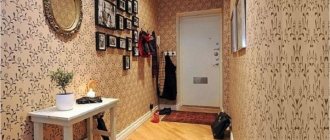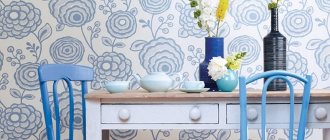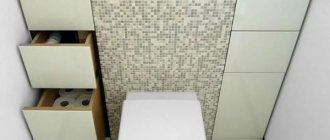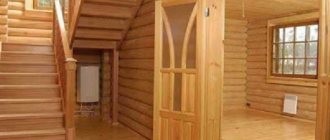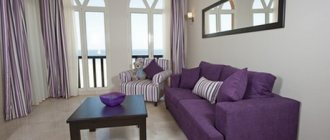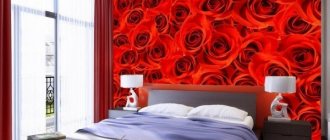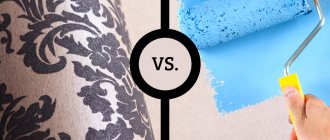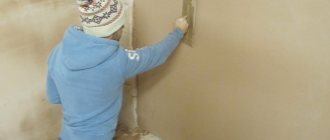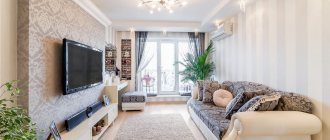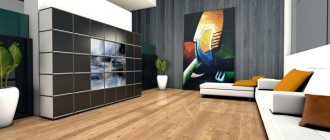Some may find applying liquid wallpaper with their own hands a rather complicated and lengthy process, but in practice everything is somewhat different. Even a beginner can cope with such a task, if the surface is properly prepared from the beginning and the mixing technologies are followed. Know how to apply liquid wallpaper correctly, and, of course, have a tool special for this material on hand.
What tool is needed for the job?
When working with liquid wallpaper you will need:
- an ordinary spatula up to 10 cm wide;
- stainless steel iron;
- trowel;
- spray bottle with water.
Note: it is not recommended to use ordinary putty spatulas as a leveling tool, since with them it is difficult to monitor the thickness of the applied solution. It is better to use a hand tool such as a metal smoother. It will significantly facilitate the application process and reduce the consumption of purchased material.
What is liquid wallpaper
Liquid wallpaper is a dry mixture packaged in plastic bags. In fact, this is decorative plaster. Initially, it was based only on natural cellulose flakes, but now manufacturers have significantly diversified the range and, in addition to cellulose, wallpaper can now contain silk, various dyes, granules, mica, pellets, foil and glitter. To improve the quality characteristics of liquid wallpaper, most manufacturers add components containing antifungal and antistatic additives. The usual adhesive for KMS wallpaper rolls serves as a binding agent.
It is worth noting that liquid wallpaper is not always sold ready-made. Sometimes there is a separate packaging of components. In a sense, this makes the process of preparing the material a little more complicated, but it also gives complete freedom to implement creative ideas. Different combinations of fillers make it possible to obtain a textured or smooth seamless coating that is interesting in color, which is not achievable when pasting with roll analogues.
What to consider
It just so happens that not all of us have certain skills and knowledge in art. If a person does not have a predisposition to create artistic delights, it will not be easy for him to create an interesting pattern on liquid wallpaper. However, there is always a way out, incl. and in this situation. So, the most common option is to use a stencil. Using this device, you can create both simple and convex images, since its main task is to draw the contours of the future image.
We recommend watching this interesting video instruction:
In addition, it is also necessary to take into account some features of the room in which the drawing will be applied. So, for example, in rooms with a small space and area, it is advisable to use paints in cooler and pastel colors, which can visually “expand” the volume of the room. As for the color for the base, it is best to use white paint. And in general, the use of various dyes (colors) allows you to diversify the palette and make the image more original, better compatible with the rest of the room’s interior.
The use of patterns with liquid wallpaper can completely transform the interior of both individual rooms and the apartment as a whole. Pay attention to interesting image ideas that allow you to apply not only small drawings, but sometimes entire paintings and panels. Happy renovation!
The best posts
- How to make a plasterboard ceiling in the kitchen with your own hands
- how to level a laminate floor
- How to make a plasterboard box in the bathroom - step-by-step instructions
- DIY decorative corner fireplace made of plasterboard
- Drywall figures or how to make the interior stylish and fashionable
- Painting drywall - step-by-step instructions
- How to paint drywall: little tricks
- Wiring under drywall: lay it out correctly
Related article: Do-it-yourself technology for laying electric heated floors under tiles (video)
Their advantages and disadvantages
The liquid finish fits well on brick, metal, wood, and drywall. The advantages of liquid wallpaper include:
- decorative eco-friendly material with a variety of colors;
- good sound and heat insulation;
- the ability to hide small flaws in the walls;
- durability of the solution applied to the surface;
- reusability;
- ease of restoration of the coating.
There is only one drawback - the high price, but the result is worth it.
Walls for liquid wallpaper: preparation before application
Although, as indicated in the instructions, decorative solutions can hide many unevenness and other flaws, before applying liquid wallpaper, the walls must be properly prepared so that cracks, rust and other unpleasant aspects do not appear after the mixture has dried. Remains of finishing material, loose layers of plaster and whitewash, bolts, and nails protruding from the wall are removed.
Preparing the wall surface before applying liquid wallpaper for different types of walls occurs differently:
Concrete walls. To avoid rust, concrete walls with metallic inclusions are painted over with oil or latex paint. If necessary, apply a starting and finishing layer of plaster and putty. To reduce absorption, concrete and brick walls are covered with a gypsum mixture. Mandatory work includes priming the surface. White primer is applied in two layers.
Drywall and plywood. Since the slabs of these materials are fastened with self-tapping screws, the heads of the screws are puttied. For ideal cladding, builders recommend applying putty not only to the joints of the sheets, but also to covering the entire surface. After which a primer is applied.
Attention: decorating solution cannot be applied to whitewash! It definitely needs to be washed off and the walls allowed to dry!
Drawings with liquid wallpaper video
A video from our customer about how easy it is to make a pattern with liquid wallpaper with your own hands. The video shows the sequence of work: start with a drawing on the wall, then apply the material one by one, first one color, then another.
Liquid wallpaper - how to make drawings
To make drawings with liquid wallpaper on the wall look beautiful and clear, first create a drawing with a simple pencil on a prepared light wall (plastered and primed). The drawing shows the boundaries between colors, i.e. where one number of liquid wallpaper borders on another. The principle is similar to a children's coloring book, but instead of paints, liquid wallpaper of different numbers is used. You can easily combine not only tones, but also different series. It is more difficult to combine pronounced textured wallpapers (Relief, Victoria, Airline) with smooth ones (Optima and Standard). All the rest have a slightly pronounced relief and can be easily combined with each other or with the above.
Are you just deciding or have you already bought this wonderful material and are preparing liquid wallpaper for application. How to make drawings is a common question. In reality, there is nothing complicated in this process. Drawings with liquid wallpaper are created according to the general rules for applying and preparing walls for gluing. We recommend that you first read the instructions on the website or watch a video of applying liquid wallpaper.
To correctly order liquid wallpaper in the required quantity, count how many different tones are present in your drawing. Determine from the catalog which item suits your color best. When calculating the number of packs, pay attention to the consumption of one package.
Order: 8-916-623-40-49 (daily from 10 to 20) [email protected]
Liquid wallpaper - modern design. Plain wall or with a pattern.
All models are in stock on our website! Liquid wallpaper with free delivery Liquid wallpaper catalog
Proper preparation of liquid wallpaper is half the battle
Preparing liquid wallpaper takes 6–12 hours, so you can start preparing the solution already at the stage of priming the surfaces. As mentioned above, liquid wallpaper can be sold both in mixed form and in separate packaging. In the first case, the finished dry mixture is fluffed by hand before adding water. If the components were packaged in different bags, the contents of all bags are poured into a large container or onto pre-spread cellophane and also mixed thoroughly.
Attention! Follow the amount of water and dry powder specified in the instructions. You cannot dilute half the packet or double knead. Otherwise, the composition will be uneven and the necessary properties will be disrupted.
The correct way to mix liquid wallpaper:
- The fluffy mixture is slowly poured into a container with clean, warm water at 20–30 degrees and constantly stirred.
- Since there are no caustic substances in the composition, everything can be done by hand. This way you are guaranteed not to damage the long fibers and ensure more thorough mixing.
- If liquid wallpaper comes with a set of glitter, granules, and dyes, then add it to the water first and stir. Then add glue. It is this method that allows you to achieve uniform distribution without sticking or lumps.
Note: usually one kilogram of liquid wallpaper is enough to process 3-4 square meters, and not 5-6, as the manufacturer claims.
Ready-made liquid wallpaper can be stored in a closed container for more than a week without loss of quality. To avoid their frequent drying out, it is worth leaving the diluted mixture in one container, and pour the required volume for working with one wall into another container.
How to apply liquid wallpaper to walls with your own hands
The technology for performing the work is quite simple. Wall finishing is carried out in the following sequence:
1. The base is prepared.
The old decorative coating is removed. Dust and dirt are removed. All visible defects are eliminated. The base is leveled. The surface is primed to increase its adhesion level.
2. The mixture is prepared.
The main components are added to the water in the sequence specified by the manufacturer of the liquid wallpaper. Their percentages may vary.
To get a mixture with the right consistency, you should carefully study the instructions. Mix the mixture thoroughly with your hands, ensuring that the dry ingredients are completely saturated with water.
To obtain liquid wallpaper with the correct consistency, place the prepared mixture in a bag and leave for 12 hours.
3. The mixture is thoroughly mixed immediately before application.
4. Liquid wallpaper is applied to the wall, moving from the corner.
Right-handers begin to work from right to left, left-handers vice versa. To do this, scoop a small amount of the mixture from the container and then spread it over the surface using a trowel.
You should move up/down, right/left. The trowel should be positioned at an angle of 10 - 15 degrees.
The steps are repeated until the wall is completely lined.
Attention! If there are sockets on the wall, finishing should begin with them, after first removing the front panel.
Applying liquid wallpaper: step-by-step instructions
Let's take a closer look at how to apply liquid wallpaper to a wall.
After the previously prepared surface has dried and the wallpaper has swollen, they begin decorative wall cladding.
Technology for correctly applying finishing material to the wall with your own hands:
- Home repairs are carried out in a room with normal humidity and at a temperature not lower than 15 degrees.
- To timely identify all irregularities, the distribution of the composition starts from the light corner to the dark.
- The solution is applied with a stainless spatula from a trowel onto the wall and leveled with a trowel to an absolutely smooth surface. The tool is not held flat, but by slightly raising the front edge by 5–15 degrees relative to the surface. As a result, the layer should be about 2 mm thick. If the mass turns out to be very thick in consistency and does not stick, you can add a little water. However, it should be borne in mind that the finished composition should not drain. Some types of liquid wallpaper may have a slightly larger or smaller thickness.
- The wallpaper in the corners is leveled using technology: the liquid mixture is distributed from the corner in the desired direction. After filling the space with a trowel soaked in water, the unevenness formed during the work is removed.
- The treated wall is left to dry for an hour. The use of heating appliances is prohibited. Ventilation is allowed, provided there are no strong drafts. After this, turn on the lamp and position it so that it illuminates the surface at an angle. All irregularities are smoothed out with water and a smoothing iron.
Tip: You can create a background image by changing the direction. In one area the composition is applied in one direction, in another area the direction changes, for example, by 45 degrees.
To ensure that the walls are well protected from moisture, damage and dirt, it is recommended to treat them with glossy or matte varnish. The work is done using a roller in 2-3 layers. After this, the walls and ceiling with liquid wallpaper can be easily cleaned.
Work technology
The first stage of working with liquid wallpaper is the production of a decorative composition.
If you purchased a ready-made diluted mixture, then you can begin work immediately: you just need to dilute the composition strictly in accordance with the instructions.
The preparation method is very simple: pour wallpaper powder into a container, pour water at a temperature of 25 degrees, stir.
Please note: you cannot stir the mixture with a construction mixer or use a spatula for this purpose, so as not to damage the long fibers.
You need to prepare the mixture with bare hands - all components are absolutely hypoallergenic.
In addition, the mixture must sit for some time: you need to prepare the composition 6-12 hours before gluing liquid wallpaper.
How to properly apply liquid wallpaper to walls?
To do this, you can use manual or mechanical methods.
The technology for applying liquid wallpaper in such cases will be slightly different.
For the manual method, use tools such as a spatula, texture roller or grater.
You can apply the composition to walls from any place: from a wall, corner or window.
Video:
The recommended layer thickness is 1-3 mm; if this is not enough (uneven surface or uneven color), you can increase the layer to 1 cm.
By changing the angle of the spatula or grater, you can vary the thickness of the coating.
The mechanical method is the use of a special spray gun.
With this method, a thin layer of wallpaper mixture is first applied, then the final layer of the required thickness is applied.
Today, the method for applying liquid wallpaper to the ceiling is especially popular. This allows you to smooth out all the unevenness and cracks, get an unusual color and relief, instead of the usual white surface.
The technique for finishing cellulose, silk or cotton wallpaper on the ceiling is the same as when working with walls.
Let's sum it up
Liquid wallpaper is a modern material, which in its quality characteristics is in many ways superior to other finishing materials. In terms of creating a unique design with a rich texture, liquid wallpaper has no equal competitors. To work, you don’t need much: you have a minimum set (mixture, water, a spatula and a grater) and a properly prepared surface of a homogeneous layer with a minimal tendency to absorb water. The applied liquid plaster is leveled, dried and varnished.
Now you know how to apply liquid wallpaper and you can make repairs in your apartment yourself without the involvement of strangers.
